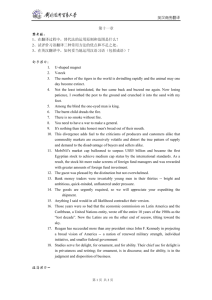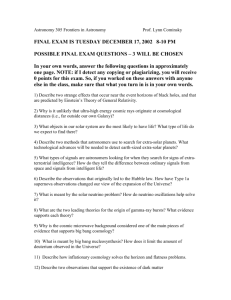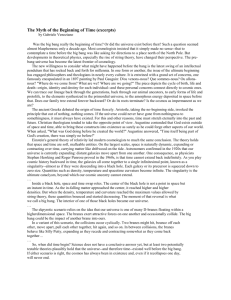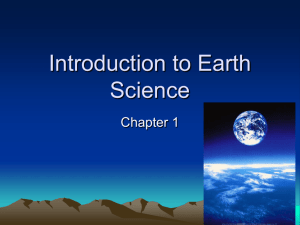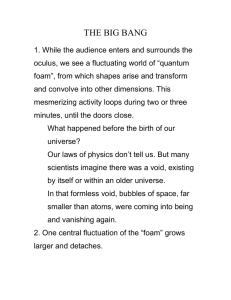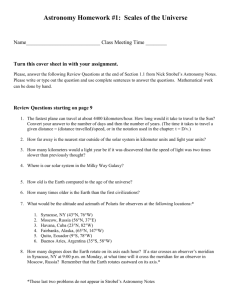History of the Big Bang
advertisement
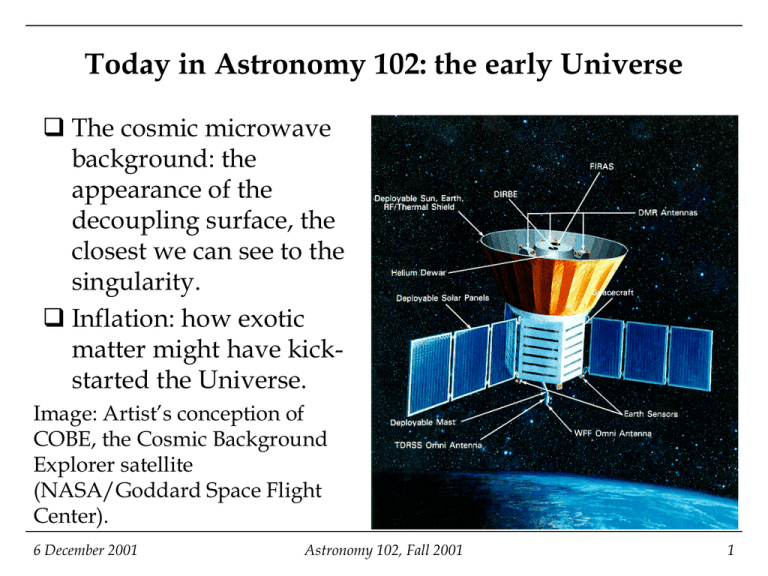
Today in Astronomy 102: the early Universe The cosmic microwave background: the appearance of the decoupling surface, the closest we can see to the singularity. Inflation: how exotic matter might have kickstarted the Universe. Image: Artist’s conception of COBE, the Cosmic Background Explorer satellite (NASA/Goddard Space Flight Center). 6 December 2001 Astronomy 102, Fall 2001 1 Observational tests II: direct observation of the Big Bang In the 1940s, George Gamow, one of the leading workers in Big Bang cosmology, predicted that the blast from the Big Bang should be detectable someday. Specifically: light would be seen that arose at the time when the Universe had cooled to the point that atoms could form. The light started off visible, but owing to the great distance of its source it would be redshifted into the microwave band (wavelengths of a millimeter to a few centimeters), and look like a black body with a temperature a few degrees Kelvin (above absolute zero). Since it was close to a singularity when emitted, the light should appear isotropic: spread uniformly across the sky. (We’ll explain why it should look like this, in a bit.) 6 December 2001 Astronomy 102, Fall 2001 2 Observational tests II: direct observation of the Big Bang (continued) In 1965, Bob Wilson and Arno Penzias (AT&T Bell Telephone Laboratories) were working on a very sensitive microwave receiver and antenna they built for satellite communication. They were trying to tune it up to reach ideal performance, but persistently found extra noise power for which they couldn’t account. They knew nothing of Gamow’s prediction. The extra power was like that of a black body with temperature 2.7 K (2.7 degrees above absolute zero). It was the same no matter which direction they pointed their antenna. ( If it comes from the sky, it’s isotropic.) They were grasping at straws for an explanation, when they were paid a visit by radio astronomer Bernie Burke, a professor at MIT. 6 December 2001 Astronomy 102, Fall 2001 3 Observational tests II: direct observation of the Big Bang (continued) Burke knew of efforts at Princeton U. by Dicke and Peebles to build a sensitive microwave receiver and antenna to look for the Big Bang radiation predicted by Gamow, but were having technical troubles. He introduced the Bell Labs group to the Princeton group. It was quickly noticed that Penzias and Wilson had indeed detected that relict radiation (now called the Cosmic Microwave Background). Thus the blast from the Big Bang is seen directly. This is the sturdiest nail in the coffin of the Steady-State Universe. For this epochal discovery, Penzias and Wilson shared the 1978 Nobel Prize in Physics. 6 December 2001 Astronomy 102, Fall 2001 4 Sky map of the cosmic microwave background COBE images of the entire sky at a wavelength of 5.7 mm, with brightness expressed as the blackbody temperature (in K) that would produce the detected power. (NASA/GSFC) Color code: blue = 0 K, red = 4.0 K. Note how uniform (isotropic) the brightness is! On a finer scale. Color code: blue = 2.725 K, red = 2.731 K. The maps are plotted so that the Milky Way lies horizontally across the middle. 6 December 2001 Astronomy 102, Fall 2001 5 Sky map of the cosmic microwave background North South 6 December 2001 The 5.7 mm COBE DMR map, again, after correction for our 570 km/s motion with respect to the average Universal expansion, and after clipping out the Milky Way within about ±20° of Galactic latitude. Blue = 2.7279 K, red = 2.7281 K. Astronomy 102, Fall 2001 6 Spectrum of the cosmic microwave background Brightness Wavelength (mm) 2 1 COBE measure0.5 ments of the background !! brightness as a function of wavelength (points), compared to that expected from a 2.728 K black body (solid curve). From Ned Wright’s Cosmology Tutorial. e j Reciprocal of wavelength cm -1 6 December 2001 Astronomy 102, Fall 2001 7 The details: questions and the short answers What does the light come from? What process produced it? The decoupling of matter and light during the cooling of the expanding, early Universe. Why is the cosmic background isotropic (spread uniformly across the sky? That’s not how explosions look in the movies. Because it comes from a place and time that is so close to the singularity in which the whole Universe used to be compressed, and because spacetime is warped, especially near the singularity. Why does its spectrum look like that? Because before decoupling, the Universe was opaque, and had a nearly constant temperature: that’s a prescription for blackbody radiation. Now for the long answers. 6 December 2001 Astronomy 102, Fall 2001 8 History of the Big Bang, the expansion of the Universe, and Decoupling Time starts along with the expansion. At the singularity, like in a black hole, time does not exist, only the four-dimensional space of quantum foam, the result of the extreme mixture and warping of spacetime (Lecture, 20 November, and Thorne, pp. 476-480). Therefore the question “what existed before the Big Bang?” is meaningless for anyone living in the Universe; there is no “before,” because there is no such thing as time at the singularity. One would have to be outside the universe to ask the question sensibly, and there seems to be no outside to the universe, either. As is the case for matter just about to form a black hole singularity, the Universe is extremely hot and dense shortly after the expansion (and time) begins. As the expansion proceeds, the Universe cools off. 6 December 2001 Astronomy 102, Fall 2001 9 History of the Big Bang, the expansion of the Universe, and Decoupling (continued) The temperature of the early Universe was too high for normal matter to exist as such. It needed to cool down in the expansion before the normal constituents of matter could condense from the high-energy soup and not be broken up immediately. Early in the expansion, energy in the form of radiation was in equilibrium with all forms of matter and antimatter, continually producing all possible particleantiparticle pairs, which would soon annihilate to produce radiation again. Energy Particle(photons, antiparticle gravitons,...) pairs 6 December 2001 Astronomy 102, Fall 2001 10 History of the Big Bang, the expansion of the Universe, and Decoupling (continued) As the temperature fell, the highest energies available in photons, gravitons and the like decreases; therefore higher-energy particle-antiparticle pairs cease to be created. When it became too cold for the most massive particleantiparticle pairs to be made, these pairs annihilated each other and turned back into photons. However, it seems that a slight asymmetry developed early that left what we call the particles slightly outnumbering the antiparticles, so that not everything annihilated: there was still some matter left over, as well as lots and lots of photons. 6 December 2001 Astronomy 102, Fall 2001 11 History of the Big Bang, the expansion of the Universe, and Decoupling (continued) Combinations of particles, bound together by electromagnetic or nuclear forces, could also form in the early universe, but when the temperature was high enough, the combinations could be immediately broken up by the photons. Examples: 6 December 2001 Quarks and gluons Protons and neutrons and photons Protons and neutrons Atomic nuclei and photons Nuclei and electrons Atoms and photons Astronomy 102, Fall 2001 12 History of the Big Bang, the expansion of the Universe, and Decoupling (continued) When the temperature gets low enough that the density of high-enough energy photons is small, the combinations stop being broken up. Quarks and gluons Protons and neutrons and photons Protons and neutrons Atomic nuclei and photons < 106 K Nuclei and electrons Atoms and photons (Decoupling) < 4000 K 6 December 2001 Astronomy 102, Fall 2001 T < 1012 K 13 ~1010 years light Time Us (t ~ 1010 years) Distance Expansion of the Universe Note: “~” means “approximately equals.” Decoupling: Atoms (t ~ 2105 years) Protons, neutrons, nuclei (t ~ 200 sec) Electrons (t ~ 1 sec) Quarks (t ~ 10-6 sec) Big Bang 6 December 2001 Astronomy 102, Fall 2001 See Silk, page 111. 14 Decoupling Proton Electron Before 6 December 2001 H atom Photon After Astronomy 102, Fall 2001 15 Decoupling (continued) Before decoupling, typical photons could destroy atoms, and so were coupled to matter in the sense that they were constantly being created and destroyed as atoms were being destroyed and created. Any photon trying to “get out” gets absorbed and reemitted many times on the way; the Universe is opaque before decoupling. After decoupling, the average photon had insufficient energy to break up an atom. All the electrons and protons combine to form atoms and emit photons, which then lead completely separate lives. 6 December 2001 Astronomy 102, Fall 2001 16 Decoupling (continued) Now photons can travel without being absorbed and reemitted constantly; the Universe is transparent after decoupling. Light coming from the “surface” where decoupling occurs is the cosmic microwave background. Because it’s opaque before decoupling, we cannot see any closer to the singularity, using light. Neutrinos could be used to see deeper. However, because all particles experience a similar decoupling, nothing can be used to see the big-bang singularity itself. 6 December 2001 Astronomy 102, Fall 2001 17 Mid-lecture break. Exam #3 is on Thursday, 20 December, at 4 PM. When do you want the review session? Homework #7 is due on Friday, 14 December, at 11 PM. At right: an expanding, twodimensional, positively-curved universe. (From Wayne Hu, U. Chicago.) 6 December 2001 Astronomy 102, Fall 2001 Recession velocity Expansion redshift 18 Appearance of the decoupling surface: why is the cosmic microwave background isotropic? Because it was emitted so close to a singularity. Compare our situation to that of an observer inside a black hole. Light emitted within a black hole horizon cannot escape (and therefore must fall into the singularity), no matter what direction it is emitted: all light paths end at the singularity. By the same token -- since light can travel in either direction along these paths -- light emitted from the surroundings of the singularity would seem to the observer within the horizon to arrive from all directions, rather than one particular direction. It would look as if the singularity’s surroundings filled the sky. As we’ve seen, this is precisely the way the cosmic microwave background looks. 6 December 2001 Astronomy 102, Fall 2001 19 Why is the cosmic microwave background isotropic? (continued) Us (emitting light) Paths of light through warped space Singularity 6 December 2001 Astronomy 102, Fall 2001 20 Why is the cosmic microwave background isotropic? (continued) Us (looking at the sky) Paths of light through warped space Singularity Decoupling surface 6 December 2001 Astronomy 102, Fall 2001 21 Why does the spectrum of the cosmic microwave background look like that? The universe before decoupling was opaque and had a nearly constant temperature of about 4000 K, so the decoupling surface looks like a 4000 K blackbody from close up. (Opaque and constant temperature is the very definition of a blackbody.) 36 2.59659e+0363 10 Sun (6000 K) 36 2 10 F i , 6000 Brightness A 4000 K blackbody F i , 4000 36 1 10 4.99771e+024 0 1 10 5 10-5 cm 1e-005 6 December 2001 0 10-4 cm Wavelength i Astronomy 102, Fall 2001 0.001 10-3 cm 10 3 22 Appearance of the decoupling surface (continued) But because the decoupling surface lies so far in the past, it lies at a great distance. Because of its great distance and the Universe’s expansion, the decoupling surface appears to us to be greatly redshifted. (Think of Hubble’s Law, V = H0D.) In the expansion, all distance intervals not ruled by local gravity grow in the same proportion. This means that the cosmic microwave background’s wavelengths will all be redshifted the same way. Thus the spectrum of the cosmic microwave background should always look like a black body, at ever lower temperatures as the Universe expands. This is a strong prediction of all Big Bang models. And so it does, as we’ve seen. 6 December 2001 Astronomy 102, Fall 2001 23 Inflation: the cosmic microwave background is almost too isotropic. The final image shows that no part of the cosmic microwave background differs in brightness from the average by more than 0.001%. It is hard to make gases, or their emission, that smooth or uniform. (Consider sunspots!) To do so would usually require that all parts of the gas be interacting with each other strongly, or that the gas be well mixed. This would not seem possible for different parts of the decoupling surface. We were once part of that surface, and the parts of it that we see today have been out of contact with us (and each other) since the Big Bang, since we’re only now receiving light from these parts and no signal or interaction can travel faster than light. 6 December 2001 Astronomy 102, Fall 2001 24 Inflation: the cosmic microwave background is almost too isotropic (continued). One theoretically-popular way out of this problem is to postulate a brief period of inflation early in the Universe’s history. Briefly, this is thought to happen as follows. Shortly after the Big Bang, the vacuum could have had a much larger energy density, in the form of virtual pairs, than it does today. This possibility is allowed under certain theoretical models of numbers and interactions of elementary particles. At some time during the expansion, the vacuum underwent a phase transition (like freezing or condensing) to produce the lower-energy version we have today. 6 December 2001 Astronomy 102, Fall 2001 25 Inflation: the cosmic microwave background is almost too isotropic (continued). While the vacuum was in its high-energy-density state, it gave a large additional impulse to Universal expansion. • Recall: vacuum fluctuation energy density is actually negative in strongly curved spacetime; virtual pairs were exotic in the newborn Universe. Thus the vacuum acts “anti-gravitationally” early in the expansion. Accounting for the vacuum’s influence in general relativity leads to a very much smoother and faster expansion. During this period, spacetime’s radius of curvature increases more like a bubble blowing up, than like a blast wave - hence the name inflation for the process. • During inflation, the vacuum would appear in the field equations as a cosmological constant. 6 December 2001 Astronomy 102, Fall 2001 26 Inflation: the cosmic microwave background is almost too isotropic (continued). The inflationary era would have been relatively brief, much shorter than the time between Big Bang and decoupling. If it lasted through 100 doublings of the Universe’s size, that would do it, and this takes only about 10-35 seconds. During the remaining “normal” expansion between the end of inflation (decay of the vacuum to its low energy density state) and decoupling, the bumps and wiggles normally present in blast waves still wouldn’t have had enough time to develop. We know of course that the Universe has become much less smooth since decoupling. The seeds for inhomogeneities like galaxies, stars and people were not sown before decoupling, however. 6 December 2001 Astronomy 102, Fall 2001 27 ~1010 light years Time Us (t ~ 1010 years) Distance Expansion of an inflationary Universe Note: “~” means “approximately equals.” Decoupling: Atoms (t ~ 2105 years) Protons, neutrons, nuclei (t ~ 200 sec) Electrons (t ~ 1 sec) Quarks (t ~ 10-6 sec) Inflation (first ~10-35 sec) Big Bang 6 December 2001 Astronomy 102, Fall 2001 28
